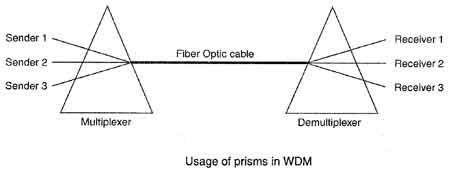A communications device that multiplexes (combines) several signals for transmission over a single medium. A de-multiplexer completes the process by separating multiplexed signals from a transmission line. Frequently a multiplexer and de-multiplexer are combined into a single device capable of processing both outgoing and incoming signals. A multiplexer is sometimes called a mux.
 Type of Multiplexer
Type of Multiplexer
Time Division Multiplexer
Short for Time Division Multiplexing, a type of multiplexing that combines data streams by assigning each stream a different time slot in a set. TDM repeatedly transmits a fixed sequence of time slots over a single transmission channel. Within T-Carrier systems, such as T-1 and T-3, TDM combines Pulse Code Modulated (PCM) streams created for each conversation or data stream.
Wavelength Division Multiplexing
Short for wavelength division multiplexing, a type of multiplexing developed for use on optical fiber. WDM modulates each of several data streams onto a different part of the light spectrum. WDM is the optical equivalent of FDM.
1. WDM is the analog multiplexing technique. WDM is conceptually similar to FDM, in the sense that it combines different signals of different frequencies into single composite signal and transmit it on a single link.
2. In WDM the different signals are optical or light signals that are transmitted through optical fiber. Wavelength of a wave is reciprocal of its frequency. Therefore, if wavelength goes up, the frequency goes down and Vice-versa.
3. Thus in WDM, various light waves from different sources are combined to form a composite light signal that is transmitted across the channel to the receiver.
4. At the receiver side, this composite light signal is broken into different light waves by demultiplexer.
5. This combining and the splitting of light waves is done by using a prism.
6. One prism is used at the sender side to perform multiplexing and another prism is used at receiver side that performs demultiplexing as shown in fig.
7. The basic principle behind the usage of prisms is that, the prism bends a beam of light based on the angle of incidence and the frequency of light wave. 
Applications of WDM
WDM is used in SONET (Synchronous Optical Network). It makes use of multiple optical fiber lines which are multiplexed & demultiplexed.
Dense Wavelength Division Multiplexer
Dense Wavelength Division Multiplexing, an optical technology used to increase bandwidth over existing fiber optic backbones.
DWDM works by combining and transmitting multiple signals simultaneously at different wavelengths on the same fiber. In effect, one fiber is transformed into multiple virtual fibers. So, if you were to multiplex eight OC -48 signals into one fiber, you would increase the carrying capacity of that fiber from 2.5 Gb/s to 20 Gb/s. Currently, because of DWDM, single fibers have been able to transmit data at speeds up to 400Gb/s.
A key advantage to DWDM is that it’s protocol- and bit-rate-independent. DWDM-based networks can transmit data in IP, ATM, SONET /SDH, and Ethernet, and handle bit rates between 100 Mb/s and 2.5 Gb/s. Therefore, DWDM-based networks can carry different types of traffic at different speeds over an optical channel.
Frequency Division Multiplexing
Frequency division multiplexing, a multiplexing technique that uses different frequencies to combine multiple streams of data for transmission over a communications medium. FDM assigns a discrete carrier frequency to each data stream and then combines many modulated carrier frequencies for transmission. For example, television transmitters use FDM to broadcast several channels at once.
Statistical Multiplexer
Statistical multiplexers make it possible for multiple RS-232 devices to share a single data line. They also perform error correction to insure error-free transmissions. The term “statistical” refers to their ability to take advantage of the intermittent usage statics of most RS-232 devices (and all PC and terminal users).
Because keyboards are idle a large part of each second with no one typing and no data being sent from the computer, each PC or terminal often averages less than 5% of its potential data rate. Statistical multiplexers allow the sum of the PC and terminal rates to exceed the composite link speed between the multiplexers. Statistical multiplexer need Buffer.
 Dinesh Thakur holds an B.C.A, MCDBA, MCSD certifications. Dinesh authors the hugely popular
Dinesh Thakur holds an B.C.A, MCDBA, MCSD certifications. Dinesh authors the hugely popular